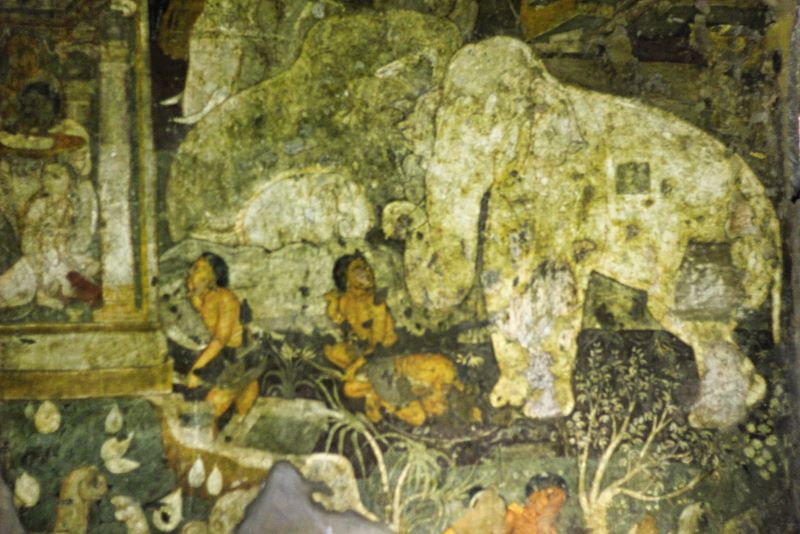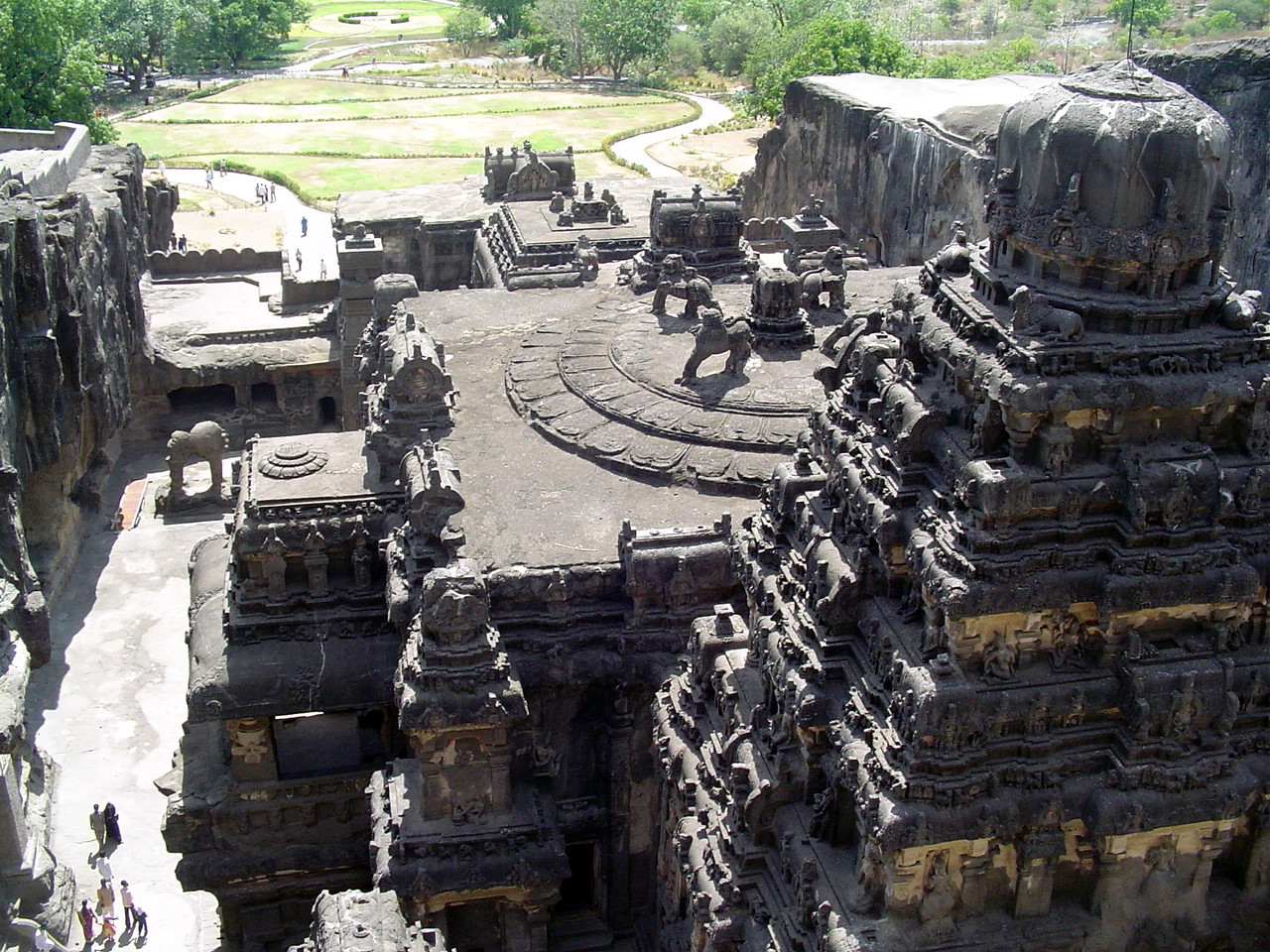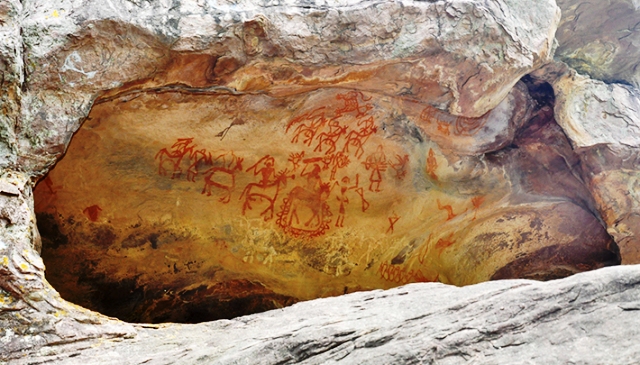- Home
- Indian Art
- Indian Paintings
- Cave Paintings in India
Cave Paintings in India
Cave Paintings:
Cave paintings
in India dates back to pre historic era. Some of the most beautiful cave
paintings that are present even to this date are the Ajanta caves, Ellora,
Bhimbetka. There are no proper written records of the cave paintings of
prehistoric era. However still many ancient cave paintings are still preserved
and well maintained in India. Here are some beautiful cave paintings in India.
Bhimbetka Cave Paintings
It is an
archaeological site that is present in Central India which dates back to
Palaeolithic and Mesolithic period. It is a UNESCO world Heritage site located
in Raisen District in the state of Madhya Pradesh India. Some of these
Bhimbetka Rock Shelters has beautiful cave paintings.
These paintings were based on the themes of animals, hunting, dancing and many more. Some of the cave paintings belong to Mesolithic period. The paintings have been classified into seven different periods namely Palaeolithic age, Mesolithic age, Chalcolithic age, Early historic and Medieval period.
The paintings
during the medieval period were mostly geometric. Some of the paintings during
this period include paintings of animals like elephant, deer, peacock and
snake. The paintings also had hunter and gatherers, carrying metals, riding
horse, fighting and many more.
Some of the
caves and the shelters are as old as around 100,000 years old. These rock
settlements show us different period of human life history right from the
hunter gatherers to settlers. The
drawings and the beautiful paintings are classified into seven different
periods.
Period I belongs to Upper Palaeolithic age where in the paintings are of animals like Bison and tiger which is painted in green and red colour.
Period II belongs to Mesolithic period. In this period the paintings were not only of animals but it also had paintings of humans and the weapons they used like the spears, pointed sticks, bow and arrow and many more. There was also painting of war between two tribal groups.
Period III
belongs to Chalcolithic period where in the paintings were quite similar to the
previous period of Mesolithic age. During this period there were paintings of
agricultural communities.
Period IV and V belonged to early historic period. In this period the paintings were more stylish and decorative. The colours used in this period were mostly red, white and yellow. The paintings were of religious gods like tree gods and chariots.
Period VI and
VII belonged to medieval period. During this period the paintings changed
slightly and became more geometrical and more schematic in nature. During this
period the colours were used by mixing black manganese oxides, red hematite and
charcoal.
There is one rock which is “Zoo Rock” which has paintings of bison, bear, deer, peacock, snake and the sun god. There are also paintings of hunting scenes with hunters having bow and arrow.
The paintings
are divided in to two large groups one as hunter and food gatherers while
others as fighters who are riding horses and carrying metal weapons.
Ajanta Cave paintings in India

They are
located at a distance of around 100 Km from Aurangabad, Maharashtra, India.
This UNESCO world Heritage place has 30 rock cut caves which dates back to
Buddhism period from 2nd century BCE. The caves has paintings of
life and rebirth of Buddha along with his preaching’s. It is believed that
Ajanta Caves belonged to two different periods. The first period belonged from
2nd century to 1st century and the second period was
after many centuries. The first period caves were 9, 12, 13 and 15A.
In these caves
the murals were based on the Jataka stories and one can see the influence of
Gupta period. The second period caves were 1 to 8, 11 and 14-29 which belonged
to Mahayana Buddhism. Majority of the caves are viharas or resting halls with
symmetrical plans. Mural paintings are present in both the earlier and later
caves. These caves have some of the magnificent paintings with bright colours.
Cave 19 is a worship hall and Cave 20 to 25 are all a monastery hall belonging
to different period. Most of the paintings have deteriorated and various attempts
have been made to maintain the paintings neatly.
The most
beautiful and important painting of Satvahana period at Ajanta is the Chhadanta
Jataka which is in Cave 10. It is a painting of an elephant named Bodhisattva
with six tusks which is related to mythological stories. The Hinayana caves
were excavated during Satvahana period.
Ellora Caves

Ellora Caves
is another UNESCO world Heritage site located at a distance of around 19 Km
from Aurangabad Maharashtra India. It is
one of the largest rock cut temples and monasteries in the world which has
Buddhists, Hindus and Jain monuments. These monuments date back to 600 CE
periods. There are over 100 caves which are excavated from the basalt cliffs in
Charandari Hills. Cave 16 is the largest single monolithic rock excavation in
the world which has Kailasha temple.
The Ajanta and
Ellora caves are closely located and are one of the major tourist’s attractions
of Maharashtra. Cave 1-12 which is located on the Southern side has Buddhists
monuments were created between fifth and eighth century. Out of 12 Buddhists
cave 11 cave have viharas with prayer halls.
The caves also
have shrines and carvings of Gautama Buddha, Bodhisattvas and saints. Cave five
is comparatively different as it has a hall with a pair of benches in the front
and Buddha statue behind. Cave 2, 16 and 17 has some beautiful paintings even
to this date. Cave 1,4,17,19,24, and 26 have some divine beautiful sculptures
and paintings all around. Cave seventeen is famous for flying Apsara painting
and image of Buddha preaching.
Cave 13-29
have Hindu monuments that were built during Kalachuri period. Caves 14, 15, and
16 were constructed during Rashtrakuta period. Cave 16 has the famous Kailasha
temple which is dedicated to Lord Shiva. The credit for the construction of
this temple goes to Rashrakutas King Krishna I.
Cave 30-34
belongs to Jain monuments. Paintings can be found only in five caves now. It is
believed that paintings took place in two stages. In the first stage the
paintings revolve around Lord Vishnu and Goddess Lakshmi while the second stage
the paintings revolves around Apsaras, Holy men who belonged to Shaivism.
Armamalai Caves
It is a
natural cave located in the Vellore District of Tamil Nadu. This cave is
converted in to the Jain temple and is the protected monument by the
Archaeological Survey of India. The cave contains Jain paintings which belong
to around 8th century. The walls and the roof is surrounded by mural
paintings. the paintings were made by applying lime surface over thick mud
surface. These beautiful paintings were usually of Jain stories and also images
of Astathik Palakas.
Bagh Caves
They are the
group of nine rock cut caves situated in the Dhar District of Madhya Pradesh
India. The wall paintings date back to between 5th and 7th
century during Satvahana dynasty. These caves are famous for the mural
paintings. These paintings were not spiritualistic and were more materialistic.
One can see beautiful wall paintings on the portico of cave 4.
Check out for other pages
Update on coronavirus in India
Affiliate Disclosure:
If you make any purchase via a link on this site, I may receive a small commission with no added cost to you.



